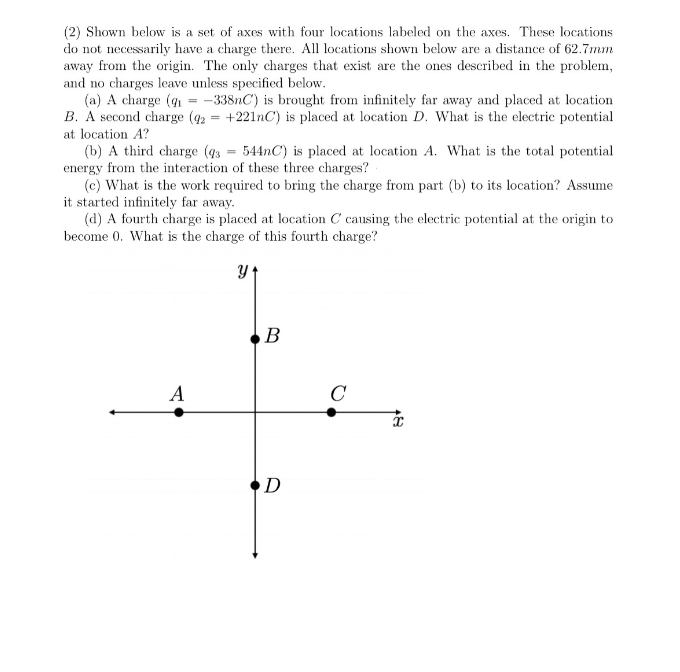(2) Shown below is a set of axes with four locations labeled on the axes. These locations do not necessarily have a charge there. All locations shown below are a distance of 62.7mm away from the origin. The only charges that exist are the ones described in the problem, and no charges leave unless specified below. (a) A charge (9 = -338nC) is brought from infinitely far away and placed at location B. A second charge (42 = +221NC) is placed at location D. What is the electric potential at location A? (b) A third charge (q3 = 5440C) is placed at location A. What is the total potential energy from the interaction of these three charges? (c) What is the work required to bring the charge from part (b) to its location? Assume it started infinitely far away. (d) A fourth charge is placed at location C causing the electric potential at the origin to become 0. What is the charge of this fourth charge? B A D
(2) Shown below is a set of axes with four locations labeled on the axes. These locations do not necessarily have a charge there. All locations shown below are a distance of 62.7mm away from the origin. The only charges that exist are the ones described in the problem, and no charges leave unless specified below. (a) A charge (9 = -338nC) is brought from infinitely far away and placed at location B. A second charge (42 = +221NC) is placed at location D. What is the electric potential at location A? (b) A third charge (q3 = 5440C) is placed at location A. What is the total potential energy from the interaction of these three charges? (c) What is the work required to bring the charge from part (b) to its location? Assume it started infinitely far away. (d) A fourth charge is placed at location C causing the electric potential at the origin to become 0. What is the charge of this fourth charge? B A D
Related questions
Question

Transcribed Image Text:(2) Shown below is a set of axes with four locations labeled on the axes. These locations
do not necessarily have a charge there. All locations shown below are a distance of 62.7mm
away from the origin. The only charges that exist are the ones described in the problem,
and no charges leave unless specified below.
(a) A charge (g = -338nC) is brought from infinitely far away and placed at location
B. A second charge (92 = +221nC) is placed at location D. What is the electric potential
at location A?
(b) A third charge (43 = 544nC) is placed at location A. What is the total potential
energy from the interaction of these three charges?
(c) What is the work required to bring the charge from part (b) to its location? Assume
it started infinitely far away.
(d) A fourth charge is placed at location C causing the electric potential at the origin to
become 0. What is the charge of this fourth charge?
B
A
C
D
Expert Solution
This question has been solved!
Explore an expertly crafted, step-by-step solution for a thorough understanding of key concepts.
This is a popular solution!
Trending now
This is a popular solution!
Step by step
Solved in 2 steps
